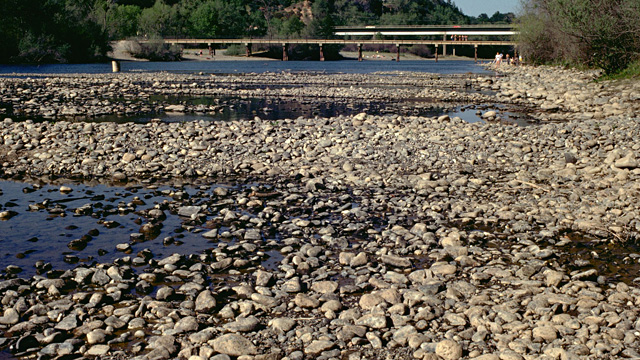
As wildlife managers fret over the effects of the ongoing drought on California’s fish, some are saying that a particularly vulnerable population of salmon may already have been wiped out by the drought.
According to reporter Peter Fimrite in the San Francisco Chronicle, coho salmon cannot spawn in coastal creeks along the coast between San Francisco and Santa Cruz County because water levels are too low.
Stafford Lehr, chief of fisheries for the California Department of Fish and Wildlife, told Fimrite that the news for Central Coast coho salmon may be very bad indeed. “The Central Coast coho could be gone south of the Golden Gate.”
Coho salmon, Oncorhynchus kisutch, generally mass just offshore before spawning season, where they wait for winter rains to fill creeks sufficiently to allow them to swim upstream. This year, those rains never came, and the coho have been unable to make it past the sandbars at the mouths of their home creeks.
One watershed north of the Golden Gate does have enough water in it for coho to have made it upstream, reports Fimrite: the Lagunitas Creek watershed, home of the state’s largest run of wild, non-hatchery-raised coho. The Marin Municipal Water District has been stepping up releases of water from Kent Dam to help the coho out.
But even in Lagunitas Creek and its tributary San Geronimo Creek, biologists have only counted 57 of the gravel bed nests, or “redds,” in which female salmon lay their eggs. That’s not a record low: the disastrous 2009 spawning run consisted of just 26 redds. But it is down by half from last winter’s count, and well below the thousands of redds generally found in the watershed in the 1940s.
Coho that spawn in creeks between the San Lorenzo River in Santa Cruz and Punta Gorda in Humboldt County are considered a distinct population, called the Central California Coast Evolutionarily Significant Unit (ESU) by the U.S. Fish and Wildlife Service. With the legal status of a distinct species, the Central Coast Coho ESU is listed as Endangered under the federal Endangered Species Act.
A coho’s typical lifespan is three years from hatching to spawning. Most coastal streams will thus have three distinct cohorts of coho salmon that call it home. Young fish may stay in their home streams for up to a year and a half before heading downstream and out to sea. If the drought keeps fish that hatched last winter from reaching the ocean in addition to barring this year’s cohort from heading upstream to spawn, creeks between San Francisco and Santa Cruz stand to lose two of those three cohorts.
More at KCET.org >>>

